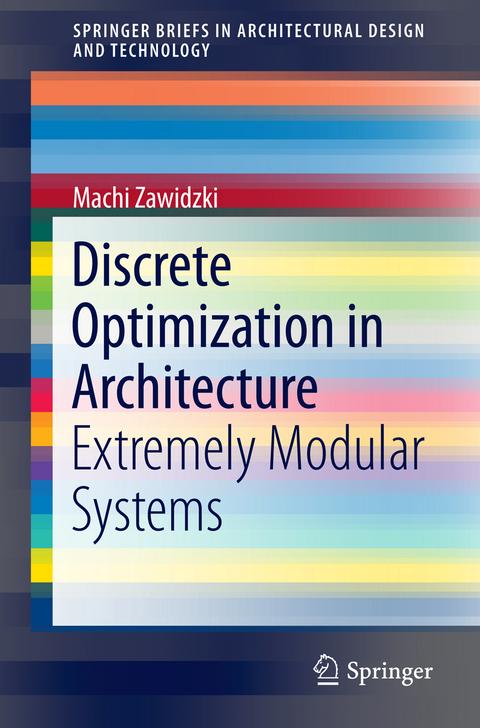
Discrete Optimization in Architecture
Springer Verlag, Singapore
978-981-10-1108-5 (ISBN)
This book is comprised of two parts, both of which explore
modular systems: Pipe-Z (PZ) and Truss-Z (TZ), respectively. It presents several
methods of creating PZ and TZ structures subjected to discrete optimization.
The algorithms presented employ graph-theoretic and heuristic methods. The
underlying idea of both systems is to create free-form structures using the
minimal number of types of modular elements. PZ is more conceptual, as it forms
single-branch mathematical knots with a single type of module. Conversely, TZ
is a skeletal system for creating free-form pedestrian ramps and ramp networks
among any number of terminals in space. In physical space, TZ uses two types of
modules that are mirror reflections of each other. The optimization criteria
discussed include: the minimal number of units, maximal adherence to the given
guide paths, etc.
Dr. Machi Zawidzki’s doctoral research focused on various optimization methods based on CI for the fundamental problems of the architectural design: Functionality, Structure and Aesthetics. His research interests are in designing built environment, especially in ergonomics and architectural design.
1. Collateral tessellation: Plaza-Z: Automated Geometrical Evaluation of a Plaza (Town Square) based on its digitized plan 2. Architectonic grid systems 2.1 Fine grid ("one cell = one agent") 2.1.1 Crowd-Z (explanation/examples) 2.1.2 Simulation in regular tessellations: Square, Triangular & Hexagonal 2.1.3 Layout improvement for smooth agent flow 2.2 Coarse grid ("cell width = corridor width") 2.2.1 Floor-Z: Constraint satisfaction approach for optimal layout design 2.2.1.1 Graph-theoretic approach (backtracking) 2.2.1.2 Parallelization 2.2.1.3 Application of Artificial Neural Networks 3. Discrete-time: passive solar shading of a free-form building with Shade-Z 4. Pipe-Z (PZ): a parametric design system comprised of a single module that allows the creation of complex three-dimensional knots 4.1 Physical and virtual PZ manipulatives 4.1.1 PZ knots 4.2 PZ optimization 4.2.1 Discrete 4.2.2 Continuous 4.3 Deployable PZ 4.3.1 Foldable PZ module 4.3.2 Space applications 5. Truss-Z (TZ): a reconfigurable modular skeletal system for pedestrian ramp networks 5.1 TZ static layout optimization 5.1.1 Single branch 5.1.1.1 Backtracking 5.1.1.2 (Other) graph-theoretic methods 5.1.1.3 Heuristic methods for TZ optimization 5.1.1.3.1 Evolution strategy 5.1.1.3.2 Evolutionary algorithm 5.2 Multi-branch Truss-Z (MTZ) 5.2.1 3D image for intersection-testing 5.2.2. Optimization of MTZ with evolutionary algorithm 5.3 Dynamic layout - deployable TZ 5.3.1 Multi-branch TZ (MTZ) deployment 5.3.1.1 Optimization of MTZ deployment by evolutionary algorithm
| Erscheinungsdatum | 08.10.2016 |
|---|---|
| Reihe/Serie | SpringerBriefs in Architectural Design and Technology |
| Zusatzinfo | 72 Illustrations, color; 46 Illustrations, black and white; XIV, 121 p. 118 illus., 72 illus. in color. |
| Verlagsort | Singapore |
| Sprache | englisch |
| Maße | 155 x 235 mm |
| Themenwelt | Informatik ► Weitere Themen ► CAD-Programme |
| Naturwissenschaften ► Geowissenschaften ► Geografie / Kartografie | |
| Technik ► Bauwesen | |
| Technik ► Maschinenbau | |
| Schlagworte | Alignment to Guide Path • Arm-Z • Breadth-first Search • Congruent Unit • Dihedral Rotation • Discrete Structural Optimization • evolutionary algorithm • Evolution Strategy • Foldable Module • graph exploration • Organic Design • Parametric Design • Pedestrian ramp • Pipe-Z • Retrofitting • Skeletal Structure • Template System • Truss-Z |
| ISBN-10 | 981-10-1108-7 / 9811011087 |
| ISBN-13 | 978-981-10-1108-5 / 9789811011085 |
| Zustand | Neuware |
| Haben Sie eine Frage zum Produkt? |
aus dem Bereich


